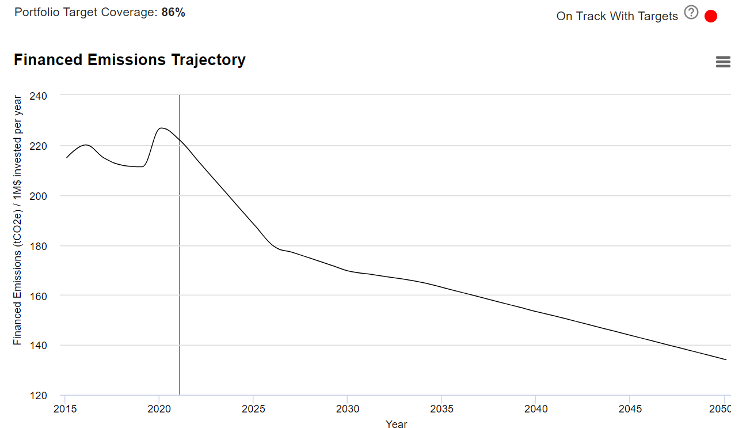
Temperature alignment - who's on track, and who's come off the rails
Published
December 2023

Climate initiatives and policies such as the Science Based Targets Initiative (SBTi) are encouraging and incentivizing companies to publish temperature targets and detailed decarbonisation plans.
But while greater transparency regarding companies’ climate ambitions is encouraging, the question remains: how can progress towards these targets be tracked, and are these good intentions even achievable?
Our analysis of companies’ progress towards their stated decarbonisation targets using ICE’s On-Track with Targets Indicator finds positive trends. However, there are significant variations both across and within sectors.
Setting targets
ICE has been collecting and analysing company-level temperature and decarbonisation targets for many years. Our latest assessment of targets data finds continued growth in the number of companies globally publishing climate commitments and temperature targets, including increases in the number of scientifically based targets aligned with the SBTi.
Earlier research by ICE found that companies with temperature targets were more likely to decarbonise, and to decarbonise at a faster rate compared to companies without a target. However, while target-setting companies may be heading in the right direction, are they doing enough to achieve their targets?
Exhibit 1: Historical and projected decarbonisation pathway of sample portfolio

Source: ICE Climate Transition Analytics Tool
While just over half of companies with targets in our sample portfolio are currently likely on-track to meet those targets, overall, the sample portfolio is currently projected to likely miss targets by more than 20%.
Hit or miss?
Running the On-Track with Targets analysis for Scope 1 and 2 targets (Scope 3 targets also available) across a sample portfolio of large cap UK companies, 86% were found to have published temperature targets. Of this 86%, our analysis found that just over half are more likely to be On-Track to achieve their publicly stated temperature or decarbonisation targets. However, as can be seen from Exhibit 1, the number of companies likely On-Track with their targets is not quite enough to take our sample portfolio out of the “Red”, meaning the portfolio is projected to likely miss targets.
The remaining companies are considered Off-Track. Of those, a majority are deemed likely to miss their targets, according to the ICE Decarbonisation Monitor. These results suggest companies that are not On-Track with their own targets are likely to miss the mark by a significant amount.
Exhibit 2: On-Track with Targets Indicator
|
On track with targets indicator UK Large Cap - Scope 1 & 2 |
Companies with targets % | Implied temperature rise (Deg C) | Sector variations | |
| On-Track | Off-Track >20% | |||
| Consumer goods | 80% | 1.51 |
|
|
| Extractives | 80% | 2.18 |
|
|
| Financials | 80% | 1.34 |
|
|
| Food and beverage | 100% | 1.58 |
|
|
| Health care | 80% | 1.27 |
|
|
| Infrastructure | 100% | 2.64 |
|
|
| Resource trans | 90% | 1.55 |
|
|
| Services | 92% | 1.50 |
|
|
| Tech and comms | 75% | 1.48 |
|
|
| Transportation | 100% | 1.62 |
|
|
| Total | 86% | 2.10 | ||
Source: ICE Climate Transition Analytics Tool.
On-Track Key: Green = more than 67% of companies on track, Red = less than 33% of companies on track,
Amber = between 33% and 67% of companies on track.
Off-Track>20% Key: Green = Of those Off Track less than 33% of companies are off track by more than 20%,
Red = Of those Off Track more than 67% of companies are off track by more than 20%,
Amber = Of those Off Track between 33% and 67% of companies are off track by more than 20%.
Sector variations
Sector and company variations are significant, and in some cases surprising. Carbon intensive sectors, such as Transportation, and Extractives, appear to be struggling to meet their own targets, with a below average percentage of companies in these sectors achieving their targets and an above average percentage of companies Off-Track.
The more surprising results are, however, generated by sectors often considered to have a lower carbon intensity, such as the Technology and Communications sector, where we found a higher-than-average percentage of companies in our sample portfolio likely to miss their targets by more than 20%.
There are also positive surprises. The Consumer Goods, Services and Health Care sectors perform well with an above average percentage of companies On-Track to achieve their targets. The Financial sector just misses out on this grouping, an encouraging performance none-the-less, as the sector has often lagged historically with regards to emissions disclosure.
Ambitions vs. achievement
ICE’s On-Track with Targets Indicator assesses the progress of individual companies, sectors and portfolios against the published temperature and decarbonisation targets of individual companies. However, the level of ambition incorporated by individual companies in their target setting (i.e. how aggressive or modest are the targets set by the company) is not considered at this stage of the analysis. This may help to explain some of the sector variations and surprises.
The ICE Implied Temperature Rise (ITR) metric, which measures the alignment of decarbonization targets to a global temperature outcome under a set of forward-looking scenarios, provides a measure of climate target ambition. When the ITR is used in conjunction with the On-Track with Targets Indictor, this can help provide context to companies’ climate progress towards their published targets.
Using the ICE ITR and On-Track with Targets Indicator together helps explain the Technology and Communications sector results. A relatively low ITR for the sector suggests higher levels of ambition when it comes to target setting in the sector, which helps explain the high percentage of companies currently Off-Track with targets.
Combining the On-Track with Targets Indicator and ITR metrics provides an innovative way to assess individual companies’ decarbonisation progress against their own climate ambitions.